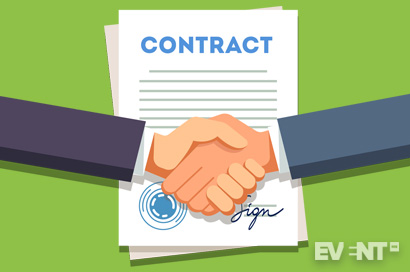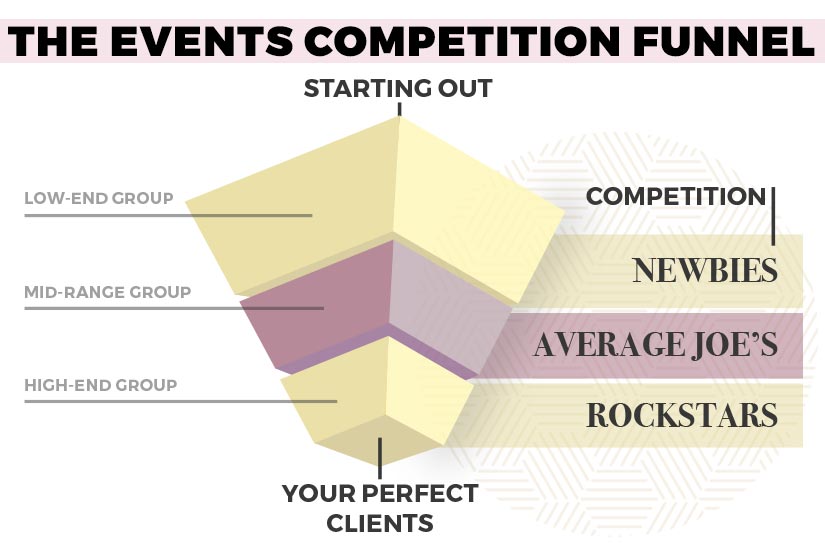Skift Take
A good event proposal can make the difference between winning a lucrative new contract and being the star of the week.
Event proposals. Two words guaranteed to make senior event planners, and anyone with a responsibility for business development, to groan.
If you miss the mark you will be walking away disappointed and confused at why you were not successful.
A lot of time and energy goes into creating perfect event proposals so you want to ensure you get the best results from the efforts put in.
In this guide, we’ll show you how to write an event proposal that will make your event stand out from the crowd. We’ll even give you an event proposal template doc that you can use as a starting point for your own killer event proposals.
Jump straight to the:
Event Proposal Template
Most importantly, we will show you where you could be going wrong so you can stop making the most common event proposal mistakes and have confidence in the event proposals you create. Don’t work on your next proposal until you have read this guide on how to write an event proposal.
13 Secrets for a Winning Event Proposal that Gets the Business
We created a quick reference guide for how to write a successful event planning proposal with 13 tactics from event professionals. Use these event proposal ideas to improve your success rate and get more business:
Download EVENT PROPOSAL SECRETS PowerpointIf you want to hit the top 5% in the event planning industry and have your proposals shortlisted by all the best clients, keep reading.
Top 10 Best Practice Tips for Winning More Business with Your Event Proposals

This post is full of top advice on how to create better event proposals and win more business. Here are 10 best practice tips we cover:
Know Your Niche and Use It To Win More Business
Add a Wow Moment to Appeal to the Heart as well as the Head
Provide Low, Medium and High Budget Points in Your Proposal
Add Plenty of Upsells in Your Event Proposals
Research Your Client’s Desires, Needs and Fears – and Answer Them
Emulate the Language of the Client in your Proposal
Pre-empt Potential Client Objections and Answer Them in the Proposal
Use Storytelling to Add Personality
Use People-centered Imagery
Use Video and/or 3D Visuals to Set You Apart
Table of Contents
Research
We know this post is essential reading for event planners, due to a few key stats thrown up by our State of the Event Industry Research 2018.
The EventMB survey is one of the biggest research studies in the event industry, with over 2,400 contacts and over 1,000 responses and some interesting findings are reported below.
If you would like a copy of the full research to publish it on your website, you can request it here: State of the Event Industry Research 2018.
Here are some headlines which really hit home:
47% of Event Planners Need More Clients
The biggest issue holding back nearly half of event planners is not having enough clients. Event proposals are often an effective way to get more business, so if you are one of the 47% keep reading this post.

31% of Event Planners Say Getting More Clients is their Biggest Challenge
When event planners were asked to share their biggest challenges overall for 2018, the 7th biggest issue (31%) was how to get more clients. This post and knowing how to write an event proposal is going to help with this!
45% of Event Planners Have More Clients Than Last Year
On the plus side, 45% of eventprofs have more clients than 12 months ago. For 43% the number of clients they have hasn’t changed though. For 12% of event planners though, they reported a drop off in client numbers.
Growth is important, you don’t want to stand still or lose business. This post is here to give actionable advice to increase your bottom line.
Definition
Buckle your seatbelts.
Let’s share some real tips for how your event proposals can get you more business, without giving you extra workload.
Part 1:
Know Your Market
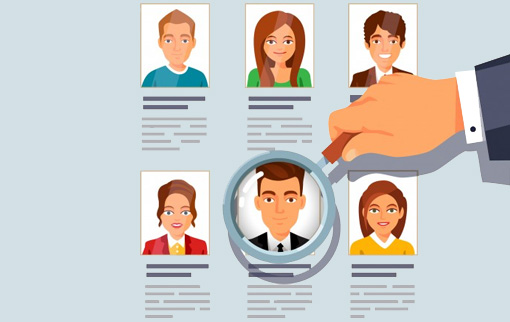
This section introduces the concept of client and competition funnels to help you better understand your marketplace and how high you should be aiming.
Use Funnels To Better Understand Your Stakeholders
You probably already know about the ‘sales funnel’. This depicts the path your prospects take from when they first discover your product or service to when they become a paying customer.
While this is a great funnel to be aware of it is not one of the funnels I’m about to introduce you to. These funnels should help you to put in perspective where your events business is now, where you want it to be and WHAT you need to consider to get there.
Once we have taken a look at these I will show you step-by-step HOW to craft event proposals that will give you the best chance of getting there as quickly as possible.
So the theory behind the funnels is that both events companies and event clients operate in one of three different levels. This may be slightly oversimplified, as they may operate in all three at the same time but the majority of their work will usually fall into one of these three levels:
LOW-END – Inexperienced competitors and lower value clients
MID-RANGE – Average competitors and medium value clients
HIGH-END – Your best competitors and highest-value clients
Visualizing these distinct levels as funnels can help you make sure you are using the appropriate event sales process or type of proposal for the right type of client.
Why is this important?
You’ll never land the clients you really want if you spend your time at the wrong end of the funnel, and you can’t craft the right kind of event proposal if you don’t understand their mindsets.
Let’s dive right in…
The Events Competition Funnel – Understand Your Competitors and Gain Advantage
LOW-END Competition
The first funnel you need to be familiar with is the competition funnel. At the top of this funnel, you’ll find the largest number of competing events companies and therefore the most competition for work. This is the lower-end of the market and likely where you started out, battling for event contracts against part-timer planner, freelancers, hobbyists, and fellow newcomers. Planners at this level often have an “I’ll take anything” mentality and don’t have a lot of time or incentive to create distinctive event proposals. There is also a tendency to take a “stack ‘em high” approach by creating simple packages that can be replicated with little to no variation.
MID-RANGE Competition
The middle of the funnel is where the majority of established events companies find themselves and it has the most difficult barriers to growth. Profit margins can still be relatively low. As your events company becomes more experienced so do your competitors. The result is often a continual struggle for event clients without big budgets. You have to work harder to get noticed so the ROI for time spent on proposals remains low. This is where you really need to start thinking about upping your proposal game so that your proposals stand above the fierce competition and you can start moving to the next level.
HIGH-END Competition
Only the best eventprofs and event planning agencies do ALL their business in the narrowest part of the funnel, the high-end level, and they can be dubbed the “rock stars” of the planning world. All companies at this level have been around for long enough to have established solid reputations, and the proposals they create are the best of the best. They know their strengths, weaknesses and where their niche is. You need to match-up. There are fewer competitors but they are the toughest competition. Despite this fact, this is probably where you want to be. Diligent work on proposals can pay off in big ways when you connect with high-paying clients and create long-term working relationships.
As you can see, the narrower the competition funnel gets, the harder you have to work to land jobs. The next funnel explains why it’s worth the extra effort.
The Events Client Funnel – Understand Your Clients
The next funnel is the events client funnel. You will notice that two elements of the funnel, the middle section and the number of people/businesses in each level, are the same as the events competition funnel. The two funnels go hand-in-hand and represent the journey most events companies make as they grow and become more established.
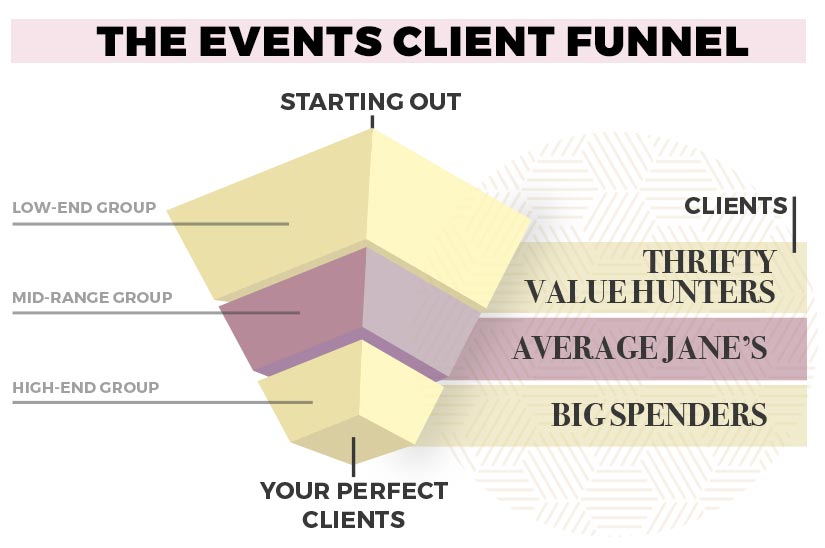
LOW-END Clients
New events companies have a large pool of potential low-end clients, but profits are minimal. These clients may be unsure of what they want, wary of spending money or impatient with the planning process. You could find yourself reworking proposals when clients change their minds, effectively lowering your ROI. When starting out with that “I’ll take anything” mentality I mentioned earlier, most event companies will have to deal with their fair share of these clients.
MID-RANGE Clients
The mid-range clients, or “average Janes”, generally have small-medium sized budgets and price-conscious attitudes. Although they demand more than clients at the low-end group of this funnel, they still may not be willing or able to pay as much as your services are worth. There are plenty of good mid-range clients that it is possible to make a living from, but as always there are also some who make unreasonable demands.
HIGH-END Clients
Applying the 80/20 rule to clients, you will get 80% of the value from the top 20% of clients. This is where you want to be. The high-end group, the big spenders, the businesses and organizations for which money is less of a decision factor, branding is key and experience is everything. There are way fewer of these clients, and you have to wow them when you find them (or they find you). They’re looking for established event professionals with the talent and resources to pull off something amazing every time. Expect them to be picky, but you can afford to put up with their demands because they’re willing to pay a premium to get perfect events. Because your competition at this level is so much higher AND the expectations of the clients at this level are so much greater, your proposals had better be incredible. At this level, you want to be creating proposals that truly stand out above everyone else’s if the hard work, time and resources you spend creating them is not going to be wasted.
The Payoffs from Aiming High with your Event Proposals
Why work so much harder on stunning proposals to land these clients? There are plenty of reasons:
- The payoffs are bigger, meaning each proposal nets more profit.
- You have more time to streamline and improve your proposal strategies.
- You establish a reputation as a reliable planner with an eye for detail.
- Building a network of high-paying clients brings in more revenue and opportunities for less effort.
Once you’ve established relationships with the right kind of companies, the potential exists to get even more work from referrals. Less time spent trying to land clients means a higher ROI and more success for your planning business.
You shouldn’t be afraid to aim high, but you have to be prepared to create a whole new kind of event proposal. If you want to attract high-end clients, your proposals must reflect the kinds of events they desire. Big spenders are looking for experiences designed to impress everyone who walks in the door and leave attendees with a lasting impression of the excellence of the company’s brand.
This is exactly what the rest of this article is about. Giving you a specific framework to follow as you create your event proposals that will ensure your proposals have the best chance of winning the hearts and minds of your prospective clients.
How To Find Your Perfect Event Niche and Get More Work
One way to stand out from the event planning crowd is to find a niche. But how do you know your niche is the right one? How do you even find one? It’s easier than you think.
The riches are in the niches is a popular phrase, especially in today’s solopreneur-driven world. Demonstrating that you are known for being the best at organizing medical conferences, for example, will give the client reassurance and add strength to the proposal.
Finding Your Event Niche
Becoming a niche expert is important in differentiating yourself from the crowd of event planners out there. But selecting your niche may take a little thought. Here are a few ways to find yours:
- A previous (career) life. Maybe you worked in healthcare and know exactly what that group needs. Now translate it to event planning.
- An underserved group. The Internet and online communities make it easy to learn about others’ needs. Look for a group (or aspect) that’s underserved in event planning and become their expert.
- Something you’re good at. Look for something you excel at and make that part of your specialty.
- Look at your hobbies and passions to find something that drives you. Now market yourself to work with similar people.
- Something no one else likes or is willing to do. If no one else likes to do it, you’ll have little competition.
Why Differentiate By Niche?
Differentiation is critical for event planners. Since the barrier to entry is minimal, many people are trying their hand at ‘party planning’. They think it will be fun and easy. So the field is quite crowded. From part-time professionals to contractors, full-timers to everyone in between, you must stand out in order land the best clients.
Finding a niche and excelling in it is a strong way to stand out, but it’s not the only one. A few others include:
- Differentiating on price
- Differentiating on service
- Differentiating through your team
- Differentiating through process
- Differentiating through expertise
So while there are multiple things to differentiate by, the one that matters is the one that yields results. Niche expertise not only does that but it also shows a degree of personalization that these other methods lack.
Personalization and the Niche
We want the services we use to be customized to our needs and our preferences. And we want them to ‘get’ us.
When you offer niche services you are telling your clients that you understand them and their needs like no general event planner can. You’ve been there and have experience that translates directly to their industry, size, etc.
Part 2:
The Essentials of Successful Event Proposals (Hierarchy of Needs)
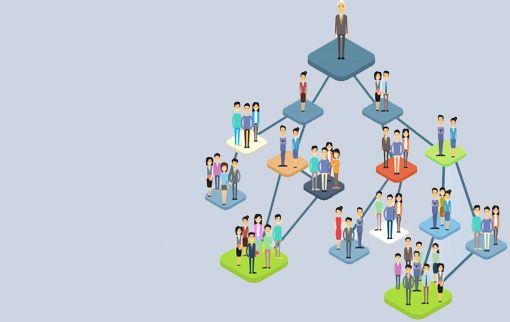
Here we introduce the concept of the event proposal hierarchy of needs as an underlying framework for creating successful event proposals.
- Does Your Event Proposal Measure Up?
- Achieving Higher Event Sales Conversions
- Maximizing Emotional Conversions to Win More Business
How Does Your Event Proposal Measure Up?
Hopefully, you’ve heard of ‘Maslow’s Hierarchy of Needs’. If not, then it is a theory of human motivation usually depicted in a pyramid.
Well, in just a second I am going to show you the ‘Event Proposal Hierarchy of Needs’, as this should make it crystal clear on where your proposals currently stand and where you can make huge improvements TODAY!
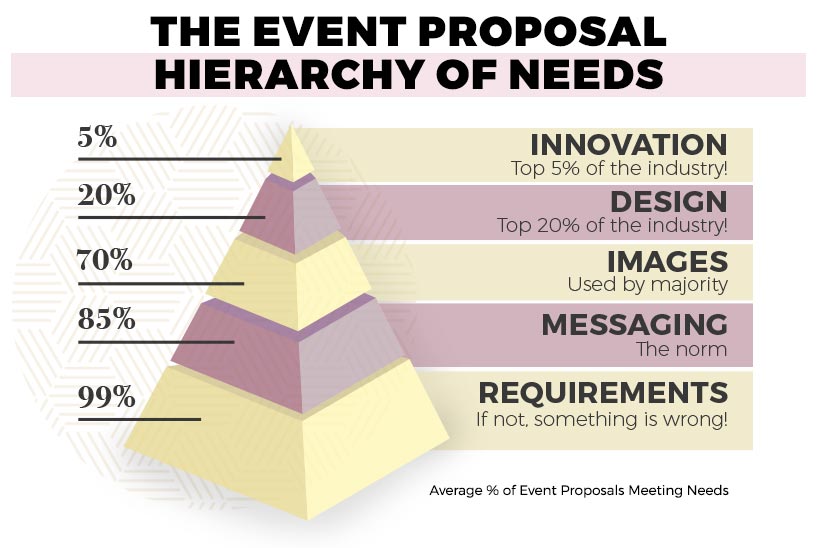
Requirements
The bottom layer of this pyramid is the basic foundation of all event proposals. This is making sure you are actually meeting all the specified RFP or client requirements for the proposal. This could come in the form of formatting instructions, the order of sections, how the budget is handled or many other things.
You HAVE to get this right or you are already out of the running. If you don’t meet these requirements then you have already shown that you are not up to the job of working on the client’s event.
The ability to follow instructions and deliver what is expected is the first test that you MUST pass.
You’ll notice that 99% of event professionals get this one right, which is great, otherwise, there’d be something seriously wrong in the industry.
Get the basic requirements right:
- Understand the basic client requirements
- Make sure your proposal meets ALL specified RFP or client requirements
- Answer all of the criteria and questions on the proposal document
- Know that you can deliver on these promises
Messaging
This is one of the most critical factors in the proposal as this is where you really show that you have an understanding of the client’s needs, desires, and fears. If you do not show that you have a good grasp of these then there are plenty of other proposals that will.
You need to demonstrate that your company is the best fit for the event by addressing the issues and explaining how your company will meet or exceed them all. Your goal here is to reassure and inspire the prospect – relevant case studies and testimonials also play an important role here. The more you can use client focused language, that is language articulated from the client’s perspective, the better.
Your messaging needs to:
- Demonstrate a good grasp of clients needs, desires, and fears
- Show that your company is the best fit for the event
- Use client focused language
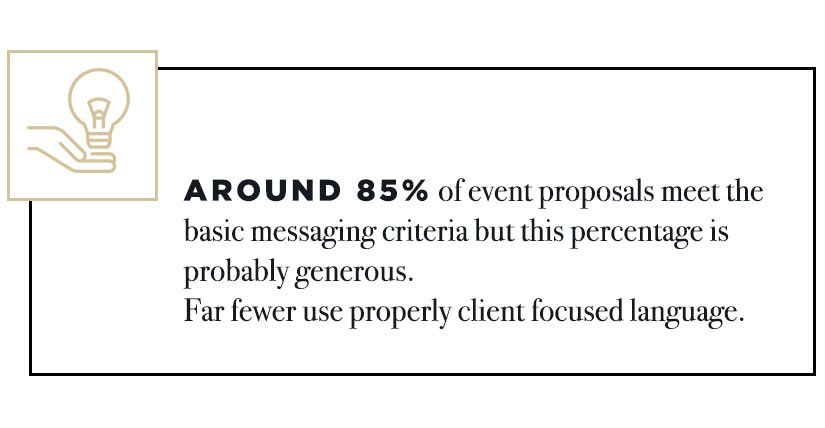
Imagery
The middle layer of this pyramid is ‘images’ and this includes the use of photos, videos and graphics within the proposal. As you can see the majority of event proposals use some kind of images to provide a bit of pizzazz, so please don’t think that you are doing anything special by adding images. Using images alone is not going to set your proposals apart, as most companies do this.
However, if you are not adding images or video to your proposals then you should start doing this straight away. Including images in your proposal helps drive your point home, especially in today’s visually oriented society where millennials are taking center stage as decision makers.
Using snippets from social media and data visualization are also excellent ways to get your point across in a visually striking way. In the highly visual world of events, a picture paints more than a thousand words.
It probably also means you are thinking about your proposals in completely the wrong way. Your proposal is a marketing document and should be treated as such. You are marketing your brand and your services.
Use images in your proposal to:
- Paint a picture of the experience you will create
- Reassure and inspire your client
- Deliver your message in a visually striking way
Design
The top 20% of eventprofs also focus on professional layout and design as a crucial factor in their proposals. I want to make it clear that there is no point focusing on this if you do not have all the other elements below in place. Great event proposal design will never make up for poor messaging so it’s only when you are confident that you have all the elements in the pyramid below this in hand that you should concentrate on this area.
Having said that, if you are meeting all the proposal requirements, your messaging is great and you have used imagery well to illustrate your event and design concepts then getting a designer in to ensure the look of the event proposal matches and elevates your brand is the icing on the cake. If you find an event proposal example design you like then adapt and stick with it!
Reasons good design is crucial:
- Great event proposal design can make your pitch stand out from your competitors
- Good event proposal design emphasizes and reinforces messaging
- Event proposal design reflects your personality, professionalism, and level of service
Innovation
Do you want to know how the top 5% of the industry get more business than all the others with their proposals?
It’s simple. They WOW their prospects with something they have never seen before, right from the first impression. They demonstrate innovation and show they have gone the extra mile, which ensures they truly stand out from their competition.
Innovation is the key to differentiation which enables you to not have to compete on price. We’ll dig deeper into this at the end of part three.
Reasons to innovate now:
- Innovation is how your best competitors are winning
- Clients are engaged and intrigued by things they haven’t seen before
- Innovation can offset costs
Achieving Higher Event Sales Conversions

It’s all about influencing your client to appeal to their heart as well as their head!
As an eventprof, you face the challenge of perfecting your proposals so that they jump out at clients and don’t get buried in a stack of competing pitches. Clients are looking to offer memorable experiences to attendees, but most proposals appeal to budgets rather than emotions. How can you show you’re in tune with the needs and desires of your clients? Pitch your events to the heart!
This is where the all-important “wow moment” really makes a difference. You’ve worked hard to apply the principles of unique layouts, stunning design, and innovative delivery to reach the pinnacle of the Event Proposal Hierarchy of Needs, and it all leads to the crucial moment when a client feels a deep connection with your proposal and realizes you have something special the competition can’t match.
Maximizing Emotional Conversions To Win More Business
Forget about trying to sell clients on how fantastic your services are. Customers in every industry recognize a hard sell, and most of them have come to dread this approach. Millennials and Generation Z are particularly wary of any marketing message in which they’re talked at rather than catered to. For the modern crowd, relationships with brands are all about having needs met and desires fulfilled.
Your clients have the same mindset. They’re not looking for a sales pitch. They want someone who can create a fantastic event from which attendees will emerge feeling engaged, energized and connected. It’s your job to move them from the initial stages of looking for an event planner to becoming “fully connected.” This ultimate state of emotional engagement makes clients 52% more valuable to your business, due in part to the foundation of trust built when you’re able to not only retain their interest but also exceed their expectations.
→Important Reading: How to Drive Event Sales with Emotions
Part 3:
Creating A Winning Event Proposal Template

This section gives you the specific ingredients needed you need to add to make your event proposals shine.
- The Single Biggest Mistake Eventprofs Make with Event Proposals
- 5 Pro Tips to Nail Your Event Proposal Messaging
- The Importance of Images in Event Proposals
- Don’t Skimp on Event Proposal Design
- Be Innovative in Your Event Proposals
- 5 Secrets to Creating Winning Event Proposals
The One Thing You Should Never Do In Event Proposals
If your client requests certain information in the proposal or a particular format, then you MUST give them what they ask for or you will most likely lose them as a potential client.
They need to know that you are easy to work with, professional and detail oriented.
Addressing the budget, as you probably know, is important in any proposal. It is likely that your client will give you an idea of their budget and ask you to create a proposal within that budget.
This is the ONE requirement that you should NOT stick to and here’s why.
My hundreds of hours of research speaking to owners of events companies and their clients brought up an interesting point about budgets in proposals.
According to various clients, as the company submitting the proposal, you need to get a ‘yes’ to the questions “are they within the budget?” or “could they be within the budget?”.
HOWEVER…
A key point that was often mentioned, which may challenge what you thought you knew about writing a proposal to a specific budget is:
If a budget is given by the company it is often only stuck to about 50% of the time.
What is more important than sticking to the rigid budget is showing flexibility. Flexibility out wins strict adherence to the budget any day and I’m going to explain exactly why in just a second.
If the budget is only stuck to 50% of the time it means that the other 50% of the time it’s almost pointless to really try to stay within that budget.
This leads nicely into why you sometimes receive an RFP or find yourself trying to create a proposal with no real, solid budget.
Planners complain about this all the time. it’s a major pain point.
I asked the clients and in-house planners I spoke with why this happens and the answer was that it’s really because the board or executive team often don’t have a dollar amount in mind and they are waiting to receive some proposals before they finalize the budget.
Win-win for the client but a complete pain in the behind for eventprofs because you spend hours, if not days, writing proposals just so the client can decide what their budget is.
One client, Emily, said that the “proposal is usually a starting point for the budget, not the end point” and that their company would often choose a mid-range budget knowing they will probably add more to it later.
So how do we overcome this disconnect and create proposals that both address the budget but are not limited by it.
The answer is simple:
Give different budget options.
There are three approaches to providing budget options:
Provide Low, Medium and High Budget Options
This may seem like more work to you but it’s a really good habit to get into for proposal writing and once you do it a few times it does becomes much easier and quicker to do as you will get a good feel for the different ballpark amounts and what you can offer for those.
Even if you start off with only two budget options (say a high and a low) then you have already doubled your chances of winning the job compared to when you were only giving the client one option – even if this is what they said they wanted.
It’s likely they weren’t 100% certain in the first place.
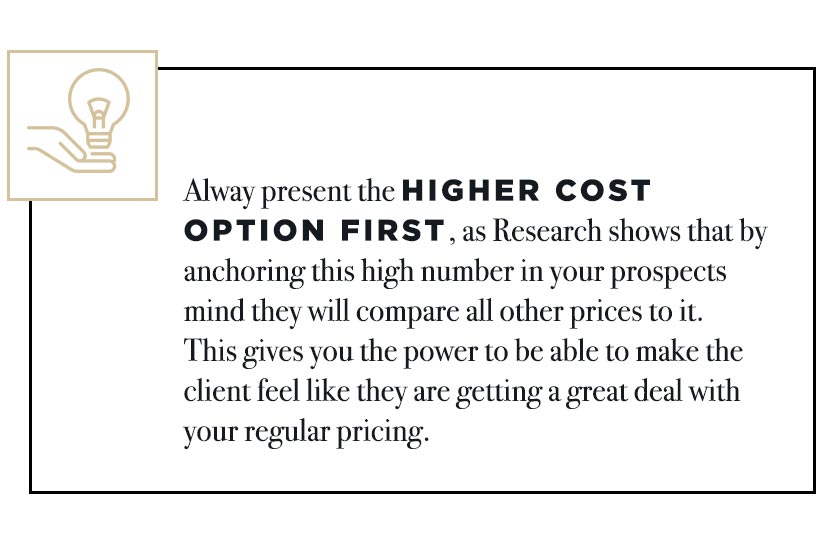
Make Sure There Are Plenty of Upsells Within Your Event Proposal
Upsells are also an awesome way to dramatically increase your revenue per proposal. The key to upselling is making sure that the upsell creates a ton of value and doesn’t detract from the original offer.
Identify and Highlight New Forms Of Revenue
Your proposal should highlight new potential forms of revenue for the client. These may include:
- Sponsorship
- Merchandise
- More exhibitor sales
- Different ticket pricing strategy
- Selling content to those that couldn’t attend and want to pay for access
Give practical examples and include statistics on what you have achieved with other events, e.g. 300% more exhibitor sales after we got on board. This is a sure-fire way to grab their attention as event income and revenue is so generally essential to the success of an event.
5 Pro Tips to Nail Your Event Proposal Messaging
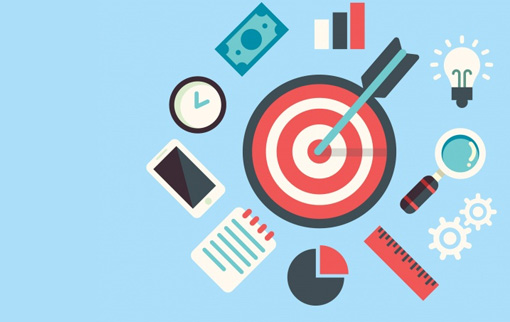
You know a good event planning proposal when you read it.
It has the power to pull you down the page, reading word for word. It engages you. By the time you reach the end, you’re so inspired that you’re redesigning your own templates.
Messaging is the second layer of the Hierarchy and arguably the most important. This section aims to give you everything you need to know to make your proposal messaging irresistible.
How can you create killer proposal copy that will engage and convert like only the best storytellers in the event industry? Start by knowing the needs and desires of your client.
Here are the 5 secrets of knowing how to talk to your clients in your proposal:
Know Your Client’s Desires, Needs, and Fears
You probably already know a bit about the client. This may not be sufficient for figuring out how to talk to them, though. You need to delve deeper and get an understanding of their desires, needs, and fears. It’s time to do some market research to determine who your clients really are. Why are they coming to you? What do they hope to accomplish through their events? Creating client personas from the answers to such questions gives you someone to “talk” to as you work on your proposal.
Do this research now:
- Look at how competitors connect with similar clients and analyze how websites within the client’s industry address “pain points”
- Monitor relevant social media chatter to find out what people in the client’s industry are sharing and discussing
- Gather data from successful events you planned for previous clients
Get Specific with Your Personas
A persona is a fictitious client representing a section of your market. Personas have names, jobs, desires, worries, and goals just like real people. You may already have these for your attendees but you should have one for each of the major types of clients with whom you work. Be sure to include what they value and what they fear so that you can speak directly to these points in your proposals. This is the backbone of client-focused messaging.
If you feel like your personas are too general, add detail from reviews, testimonials, and feedback.
Conducting even a simple interview like this gives you concrete answers to questions to which some event professionals mistakenly assume they already know the answers. Don’t fall victim to this mistake. There’s nothing wrong with asking clients questions. You need the details of what went right at an event and what didn’t and their motivations for working with an event planner. Use this to figure out what is most important to your clients. This can help you to win more business and to figure out where a proposal fell flat and what you can do to improve in the future.
Personal connections put you right inside your client’s head and help you refine the personas on which you base future proposals. The more the client you are pitching to client believes you intimately understand them, the better your chances of landing the event contract.
Ask your clients these questions after the event to assess a client’s attitude:
- In your own words, tell me about the success of the event. Be as specific as possible – What did you like? How did you feel?
- Tell us what you think we could have done that would have made this event even better
- Tell us how you felt before hiring an event planner vs. how you feel now
Focus the Language on the Client
You need to shape your proposal around what your client really wants. A lot of event planners don’t pause to think about their customers. They create proposals based on what they think their client wants or what they want to tell them. Even worse, they start with a boilerplate proposal without considering if it resonates with the client. You have to address what your client really cares about.
Your clients don’t want a particular caterer or AV supplier. They want an event that creates value for its stakeholders, and your proposal needs to show how you’ll make sure they get it. A corporate executive wants to create a specific company culture for the employees. He doesn’t care about the music you pick as long as it accomplishes his goal.
You can improve your proposal copy by using the exact language clients would use to addresses their dreams and fears. But most event planners use vague language.
For example, a lot of websites in the fitness industry simply say “Get Fit” or “Lose Weight.” This is too generic and doesn’t really dive into the customer’s dreams and fears. Compare that copy to something like “Save those jeans you love but can’t fit into anymore. You will be looking and feeling better than ever!”, and you’ll understand what a difference client-focused messaging can make.
Bringing this back to the events industry, let’s look at what an event stakeholder might say:
- “I want to make sure I’m getting the most value from my investment”
- “I want the attendees to associate a great experience with the brand”
- “I want people to engage with the brand in new ways”
I’ve seen too many corporate proposals recycled and used in the event industry or vice versa. It just doesn’t work. It’s not relevant enough.
How to Make Your Language Client-focused
What this means is that you are thinking about and telling them what they want to know and NOT what you want to tell them. If way more of your sentences start with ‘We’, ‘Our’ or your company name rather than ‘You’, ‘Your’ etc then you are probably getting this wrong.
Do this to make your messaging more impactful:
- Use the exact language your client would use
- Focus on information that is relevant to the client needs
- Never be vague
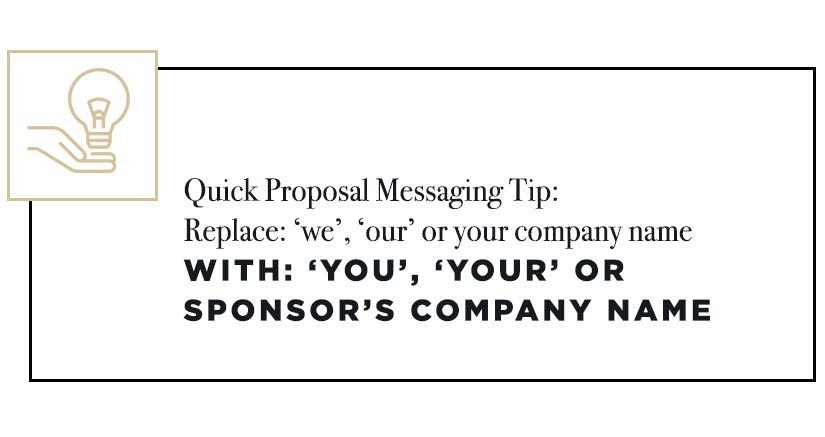
Give Them The Details
Once you know what your clients expect, tell them exactly what they’re going to get when they choose you as an event planner. Don’t be vague. You need to lay out the entire event for them as it relates to the services you are going to provide. Tie the details back to what they care about. For example: “Our event app suite will give you real-time attendee feedback from sessions giving you insight into who is engaging with the brand”
This is one of the most important factors of messaging. You want to provide enough detail that your client can visualize just how amazing their event could be. Your goal is to inspire with these details NOT make the reader run for cover with detail overload.
Rest assured you are not telling them how to do it, you are just clearly sharing your ideas and the value you are proposing to create for them.
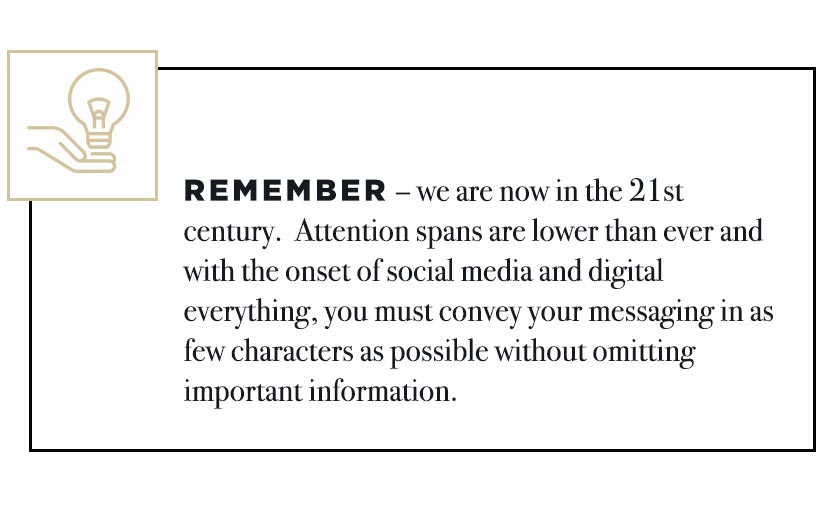
A lack of clarity leads to frustration, especially if it means clients feel like they’re in the dark or unclear about important details after reading your entire proposal.
Anticipate a List of Possible Objections and Answer Them in the Event Proposal
As part of the details, your proposal should address any objections your clients might have. How do you know what objections to expect? Make a list of the most common questions you get once you send your proposal. These demonstrate gaps in the details that should have been provided in the proposal.
Meeting a client’s needs and addressing problems is more important than selling yourself. Event planning is about the client, not about you.
Reassuring clients you’re the best person to handle an event is also critical to making sales. Some event planners think having testimonials on their websites is enough to show how great their services are, but potential clients aren’t going to take time to hunt down “social proof” of your worth. Put praises from previous clients right in your proposals.
Dial in on detail:
- Dial in on the right details – present details that relate to the client’s needs
- Try to foresee and answer client objections by making a list of the most common questions you get back and including it in the proposal
- Include testimonials and statements of praise – link to video testimonials whenever possible to make the biggest impact
Add Your Personality
Is putting personality in your proposals easy? Not really. But that’s why so few planners do it and why it will give your proposals a better edge.
There are a ton of ways you can show your personality. For example, find a way to tell a personal story, perhaps in the “Introduction” section of your proposal if you have one. You could also inject more humor into your proposals or drop in a few emojis. Unprofessional? Probably, but for social events clients it shows you have a personality and suggests you’re easy going instead of stuffy.
The personality that you use in your proposals is one of the quickest ways for a prospect to get an idea of what an event will be like. If you have a dry and boring proposal, your prospect will think that’s exactly how your event and working with you is going to be.
Personality is a big part of what makes your event planning services preferable to the competition and sets you apart as the best choice. Why struggle with trying to outdo other planners with lower prices when you could differentiate your services by using language and elements unique to your proposals?
Lowering prices just to get clients is a vicious cycle and puts you in a losing game against your competitors. Clients who base their choices only on price aren’t likely to come back in the future if they find what they perceive to be a better bargain elsewhere. Creating distinctive event proposals designed to make clients feel as though they’re right in the middle of the event promotes loyalty and makes pricing a moot point.
Get more sales by adding personality:
- Infuse the message of your proposals with a signature style to build trust with clients – give them a sense of what you’re like to work with and whether or not your events will reflect the culture and atmosphere they want
- Keep your brand personality consistent across all your marketing, including social media posts, to show potential clients exactly what they can expect when working with you
- Invest time and energy into getting to know your clients and you’ll start producing perfect proposals with messaging crafted to match exactly what they want
The Importance of Images in Event Proposals
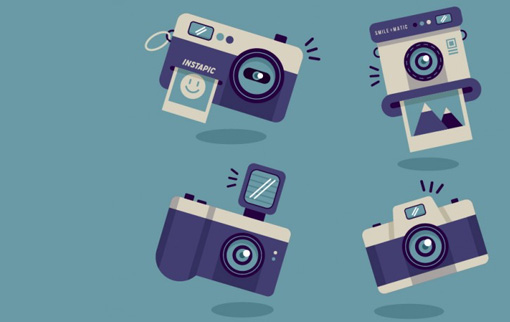
As humans, we’ve communicated through images since long before written text was ever around.
We’ve come to love images and visualizations. People are attracted to images more than text. And we can process them much faster. As an event planner, you can use this to your advantage and improve the results of your proposals.
Images have the power to tell your prospect what it’s like to work with you, the type of events you can plan, who you are, and more. If images have so much power, why do many of us use the wrong images or don’t use any images at all?
We know we should include great images, but we don’t because:
- Taking professional images of your own events can be a challenge when you’re a busy eventprof and not a professional photographer.
- Getting images of people at our events is hard. I don’t want to feel awkward as if I’m intruding so I always take images before the event.
- Formatting images into the proposal can be a pain in the behind.
In this section, I’m going to show you the type of images you will want to include in your proposals if you want to produce better results.
What Type of Images Should You Include?
Even though images are more powerful than words, it’s not enough to throw any random image into your proposal. Images are a double-edged sword. They have the power to attract your prospects or really repel them — if you use the wrong image.
Before I get into the types of photos you should be including, keep in mind that your images need to do one of two things:
INSPIRE your client about the type of event that you will be planning and the services or activities you offer.
Make them FEEL that you are the right company for the job.
That’s it. If an image doesn’t do one of these things, then it shouldn’t be placed into your proposal.
Every single image needs to earn its way into your proposal!
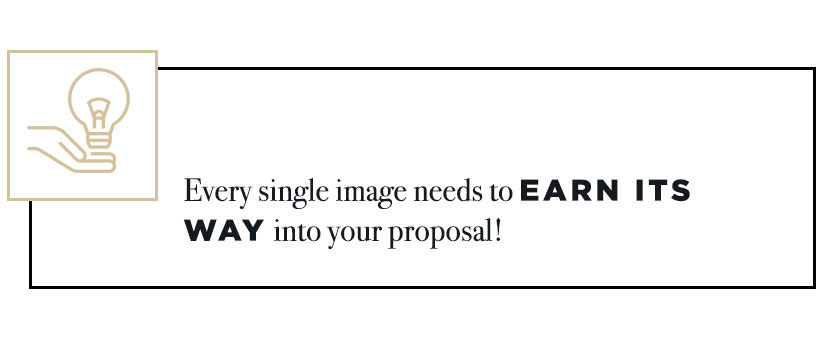
Don’t Forget: The Power of People
The photos you add to your proposal should either include people or the environment. A lot of planners have no problem including images of the venue, so I want to focus on images of people. Because fewer planners use images of people, you will be able to stand out from your competition and increase your odds of having a winning proposal.
People in images will help your reader imagine themselves or their attendees in the photo. They can begin to experience what it is like to have you plan an event for them. I like to tell planners that a photo without a person is like looking at a car on a lot. Images with people are more like taking that car for a test drive to feel how it rides.
The apartment complex that I live in gets this. Over half of their images include smiling people in different settings in the apartment community. I’ve never seen an apartment community do this. It made my decision on where to live really easy.
Conference planners can include busy workshop sessions packed with engaged participants. A destination planner can take photos of executives enjoying themselves by the poolside or at a conference table.
We want to place images that tell stories about what it is like to work with us. So, how do you get photos?
Using Stock Images or Your Own Pictures
It’s better to use real images of real people. Consumers are becoming smarter and smarter. They can tell when an image is fake. They know you didn’t really throw that party for the happy couple or those corporate executives. Do you think this deepens the trust between you and your prospects?
Stock images don’t perform as well as your own images. They’re an easy source for quality photos, but you run the risk of having the same photos as other planners and being too generic.
Your images should be of your events and your customers. This will convey a sense of trust and send the message that you’re better to work with. I know the biggest problem with including your own photos is quality.
A lot of the events that you plan will have photographers there, so connect with the photographers and ask if they would send some of their photos to use. I’m surprised at the number of wedding planners that never take advantage of this.
Create Winning Event Proposals Now
If you want to increase the odds of creating a winning event proposal, do the following:
Include high-quality images.
Use images of people. It will separate you from the crowd.
Use your own images rather than stock images.
Take better photos or hire a professional photographer to take event photos for you.
Don’t Skimp on Design
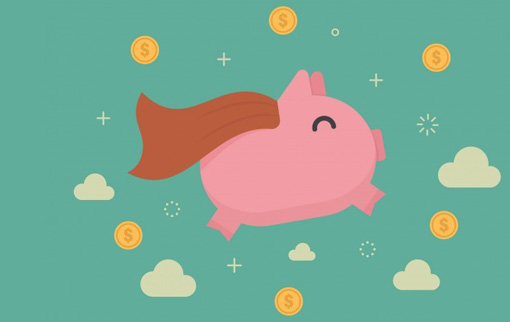
You put a lot of time and effort into your event proposals with no guarantee the finished product will land you a job. Every moment is spent trying to make your proposal jump out of a stack of others and catch the eye of a client. Since you’re not getting paid to create the proposal itself, you want to do everything you can to maximize your chances of being chosen to coordinate an event.
Eventprofs have several options when it comes to design, but not all are created equal. Your goal should always be to present professional, unique proposals to clients. Let’s look at five possibilities for pitching your event planning services and the pros and cons of each.
While a bespoke design for every proposal might give the best results, it’s not always practical. Creating professional editable templates and boilerplate content that can be adapted easily can save a lot of time and money. For example, your environmental policy probably doesn’t change very often so why rewrite it for every proposal?
4 Hot Tips for Designing Event Proposals that Win
Get an In-House Designer
Hiring someone to work as a graphic designer brings professional talent to your company and ensures you always have someone on hand to work on proposals. These designers have the training and experience necessary to create the kinds of layouts clients love to see, and they can tackle templates while you dedicate yourself to planning amazing events.
In-house designers can put together a library of appropriate layouts for every event type. When it comes time to put together a pitch, all you have to do is pop up the best design for the job and get to work. You never find yourself scrambling for the perfect layout at the last minute.
Having your own designer on staff, however, can be expensive. It takes time to search job sites and conduct interviews as you look for the best fit for your company. Once you find the right person, you have to budget around $51,000 per year to keep them on board. If you run a small company, this option is likely to be out of reach.
Find a Freelancer to Make a Master Template
If all you need is a custom “master” template on which to base proposal, you can go on sites like Scout, Upwork, 99designs, Guru and PeoplePerHour to find talented freelance designers. Browse portfolios for suitable styles, and hire the right person for any job. It’s also possible to post the work you want doing and let freelancers bid on the project.
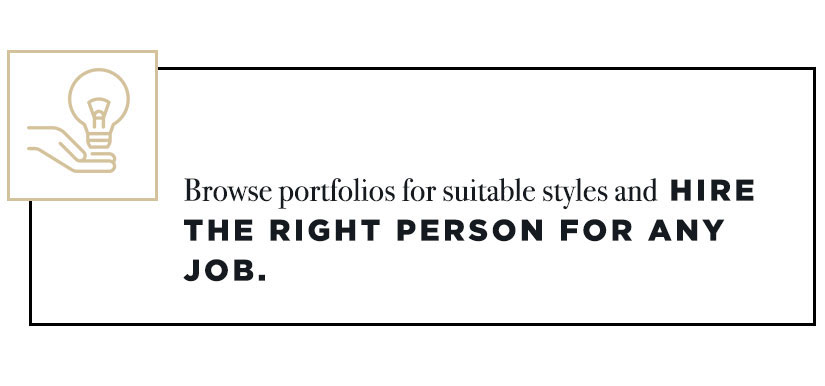
This design solution works if the majority of your proposals follow a similar format and you have enough experience to tweak a basic template to meet the needs of individual clients. Costs vary depending on the experience of the freelancer and whether you agree to an hourly or per-project fee. You’ll probably wind up paying a few thousand dollars for a template you can use for most proposals, but major changes may require investing in a new design.
Make Your Own Designs with a PDF Creator
Event planners with a decent amount of talent and design experience can use tools like Acrobat Pro DC, InDesign or Nitro Pro to speed up the proposal creation process. There’s no time spent searching for outside talent, and these programs offer a great deal of flexibility for layouts.
PDF creation and editing tools can cost a few hundred dollars to purchase outright. Cloud-based solutions range in price depending on how many licenses you need and the number of options you want in your “toolbox.” With these programs, you’re free to incorporate fonts, photos and other elements you already have on hand to create a high-quality finished product. However, unless you’re pretty adept at creating layouts, you could wind up wasting time on small details professional designers could handle without a problem.
Customize Free Event Proposal Templates
Most people are familiar with Microsoft Word and PowerPoint, and both tools have a very small learning curve. Free event proposal templates are available online and can, in theory, be used to drive event sales if you find an event proposal sample doc you like. Customizing these templates is a quick process, but creating a layout suitable for a proposal can be a challenge. Formatting text and positioning elements is tricky, and many eventprofs waste hours of valuable time trying to make everything on their event proposal sample look “just right.”
As with PDF creators, your final formatting options are limited. The settings on your client’s computer could make a standard document or PowerPoint file look wrong, so a PDF is usually the best choice despite its limited flexibility and “flat” appearance.
We created this event proposal template checklist to help you.
Use this checklist to help you create the perfect client-focused event proposal every time.
Download the free event proposal sample PDF Download the free event proposal sample Doc
Download the free event proposal sample Pages
Be Innovative
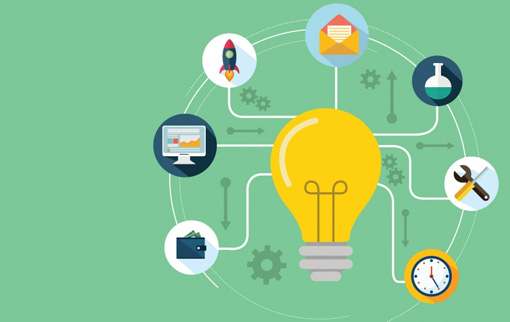
Why Innovative Event Proposals Convert into Business More than Standard Proposals
It’s time to look at the very top of the pyramid and see how innovation can transform your event proposals from bland, static presentations to dynamic online experiences.
Fulfilling client requirements, mastering the art of messaging, including the right images and creating unique designs puts you on par with the top 20% of event profs. Wouldn’t you rather be among the elite in the top 5%, grabbing the attention of high-paying clients and leaving the competition in the dust?
The only way to achieve this is to pour your energy into being innovative in every proposal you create. Getting sales from clients with complex needs means changing the way you present your event plans.
The Power of Innovation in Event Proposals
U.S. Economic policy initiative, The Hamilton Project defines innovation as “the process of discovering new ideas and realizing those ideas at large scale” and asserts it can have a powerful impact on the way people “live and work.”
What does this mean for event profs? You have to reimagine the way you think about proposal design and delivery, focusing on what you can do to impress clients and drive event sales. Conversions are key in any business, and concentrating on innovation has the potential to significantly boost your earnings.
Why Innovate?
There are three main ways innovation makes a difference in the event planning business:
Create Better First Impressions with your Event Proposals
Clients have seen dozens of proposals over the years, and most featured the same elements arranged in similar layouts. Delivered as PDF files or even on paper with an event proposal letter, these pitches failed to include the “wow factor” necessary to engage a client at first glance. An innovative approach takes a fresh perspective and uses ground-breaking design elements to make the best possible impression on clients, putting you at the top of the list of planners to contact.
Establish Positive Brand Perceptions
In today’s marketing world, your brand is your business. Taking the initiative to create event pitches unlike any your client has seen gives you a reputation for excellence and makes your planning company the one clients think of when they need someone who will break the barriers of mediocre event planning to deliver a truly memorable experience.
Differentiate Your Planning Business
The top 5% of planners look at the competition and determine how they can serve clients better. Basic proposals are a dime a dozen, but you want to be known for creating events clients and attendees talk about for years. Taking a unique approach and being willing to go above and beyond expectations makes you the ideal planner.
5 Sure-fire
Ways to Make
Your Event
Proposal
Stand Out

Once you understand the importance of innovation, you have to put this knowledge into practice when designing event plans.
These distinctive features can skyrocket your proposals past those of the competition and put you in the running for all the best event sales:
Enhance with Video
Many events report seeing higher conversions when using video as part of their marketing strategies. Including video in your proposals not only makes them look better but also presents an opportunity to engage the client on a deeper level, increasing the likelihood of conversion.
Let Testimonials Speak for You
Written feedback with pictures of satisfied clients is powerful enough, but companies including videos on landing pages usually see conversions increase as a direct result. Since your proposals are effectively landing pages pitching your event ideas, collecting video testimonials not only provides support for the quality of your services but also takes advantage of the power of visual media to inspire action.
Embrace 3D Visuals
If a picture is worth a thousand words, how much more does a three-dimensional rendering say to clients? Using a program like AutoCAD or Sketchup takes your event plans to the next level with complete models of specific event areas. Clients can see booths, conference rooms, dining halls and more in realistic detail. Getting past the learning curve for these tools gives you a skill your competitors may never master.
Put Clients Inside Venues
Many venues are beginning to offer 360-degree virtual tours of their facilities online. Incorporating these into your event pitches blows traditional venue descriptions out of the water. When you let clients “walk around” the space you plan to use, they get a clear understanding of how the venue and its included amenities will enhance the event without having to leave their offices for an in-person visit.
Use a Stunning Format
Well-designed PDF documents are a great start but modern technology now allows us to do much more. Modern proposals can also be delivered as dynamic web pages or presentations designed to give clients an immersive experience. Far more than simple sales pitches, these enhanced plans can serve as tours of whole events, giving clients a full picture of your proposed approach and showing exactly how you’ll pull everything off.
5 Secrets to Creating Winning Event Proposals [Video]
Want some extra pointers on creating better event proposals in video format?
Here you go!
In Conclusion
If you want to hit the top 5% in the event planning industry and have your proposals shortlisted by all the best clients, make innovation your goal. Putting your clients at the heart of an event with proper messaging and powerful visuals creates an emotional connection and gets them excited about working with you. Start thinking like an innovator, and see how a whole new event proposal design and these top tips on how to write an event proposal can transform your event planning business.
Now onto you:
- Do you have a tip to make this page better? Send an email to [email protected].
- Do you have more tips and advice to add about how to create winning event proposals and get more business? What learnings can you share about how to write an event proposal? Have you got an event planning proposal example you want to share? What event proposal ideas have improved your success rate and got you more business? Comment below.
- Do you have a colleague who may benefit from reading this page? Share it with them.
Further Related Reading:
